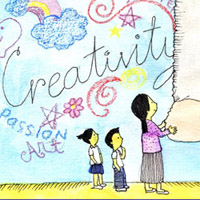Why Singapore’s English Teachers Should Embrace Singlish, Not Fight It
Is it time for Singaporean educators to embrace Singlish as a legitimate learning tool? What the Research […]
Read More
Researcher and educator Dennis Sale tells us why creative teaching is not as complicated as it’s made out to be.
 Over the last two decades, Dennis Sale has observed over 4,000 teaching professionals and analysed countless student feedback responses to try to understand the behavioural patterns of high- and low-scoring teachers.
Over the last two decades, Dennis Sale has observed over 4,000 teaching professionals and analysed countless student feedback responses to try to understand the behavioural patterns of high- and low-scoring teachers.
Through this process, he has developed a better understanding of the things that teachers do that can result in a student feeling bored and frustrated or interested and engaged. This has led to the development of the creative teaching framework, a practical, research-based approach which demonstrates what creative teaching looks, sounds and “feels” like.
The idea and desire for creative teaching is nothing new. There is, however, a limited consensus on what “creative teaching” means and a lack of practical models that can help teachers develop such competence.
This has lead to two major problems: too much “fluff” obscuring the definition of what creative teaching is and too much “stuff” being written about how to put it into practice. As a result, teachers are so bombarded with everything from learning styles to habits of mind that it is easy to forget what creative teaching really is about.
For Dennis, becoming a creative teacher is not simply about abandoning traditional methods such as lectures and worksheets and replacing these with more active projects or problem-based learning approaches. “Methods don’t make creative teachers,” he says. “For example, teachers can choose to use ‘creative thinking tools’ in the classroom but actually be very uncreative in the way they make use of them.”
According to Dennis, creative teachers are able to weave together effective and engaging strategies – using a range of methods, activities and resources as building blocks. To do this well, teachers must understand “good pedagogy” and be able to apply core principles of learning in their lesson design.
“Many teachers, however, still violate core principles of learning by overstretching attention spans and creating cognitive overload – a psychologist term for too much information too quickly. Also, they fail to recognise that motivational strategies are just as important as content selection,” he says.
Creative teachers, by their very nature, are not limited to any paradigm of psychology or education. “I disagree with the idea that teachers have moved from the ‘sage-on-the-stage’ to the ‘guide-on-the-side’. This is dangerous nonsense!” he exclaims. “Creative teachers are whatever the learning situation requires.”
At the same time, teaching students to be creative need not be a very complicated process involving overhauling the curriculum or one’s teaching style. In fact, Dennis believes that a lot can be achieved through personal modelling, “If you are a creative teacher, the very nature of being creative allows people to experience you as someone interesting and lively. If you get their attention, students will copy aspects of your behaviour – either explicitly or latently.”
So how can teachers develop their creative teaching competence? Dennis believes that teachers can improve their creative teaching by building on five important resources, summarised by the acronym SHAPE:
Based on classroom observations, interviews with teachers and student feedback responses, Dennis found that teachers who students perceive as creative were those who were able to effectively combine different aspects of SHAPE in their teaching.
“What creative teachers do, in a nutshell, is the ability to simplify and motivate. They are able to take difficult concepts and principles and weave them into a classroom experience that connects in the most simple and meaningful form to students. This is creative teaching in its most advanced form,” he explains.
At the same time, the framework also “demystifies” creativity and demonstrates creative teaching as something that can be developed and improved. “All of this is empirical and can be demonstrated,” says Dennis. “It’s not a load of fluffy words about being passionate or promoting independent learning. It’s totally behavioural and you can learn to do it.”
Yet, while the creative teaching framework offers a practical way to teach creatively, Dennis reminds us that the first step towards teaching creatively still depends on one important factor: the teacher’s motivation to want to be effective and creative. “There is no such thing as a creative switch that you just switch on. Being creative is just like everything else. You need to know how to do it and then put in the massive effort.”
Dennis believes that those who choose to teach creatively will see the results of their hard work, “I know that if I’d taught creatively, it will have a powerful impact on my students – well on most of them, most of the time.”
Interested in learning more about the creative teaching framework?
Download Dennis Sale’s paper, “Developing a Creative Teaching Framework Based on a ‘Science of Learning’“.